Podcast
Questions and Answers
How many moles of H2O are produced when 5 mol of NH3 completely reacts with O2?
How many moles of H2O are produced when 5 mol of NH3 completely reacts with O2?
- 7.5 moles
- 4.5 moles
- 5 moles
- 6 moles (correct)
What is the molecular weight of 1 mole of ethane (C2H6)?
What is the molecular weight of 1 mole of ethane (C2H6)?
- 32.0 g/mol
- 24.0 g/mol
- 28.0 g/mol
- 30.0 g/mol (correct)
In the reaction 4NH3 + 5O2 --> 6H2O + 4NO, if 3 moles of NO are produced, how many moles of H2O were used?
In the reaction 4NH3 + 5O2 --> 6H2O + 4NO, if 3 moles of NO are produced, how many moles of H2O were used?
- 4.0 moles (correct)
- 3.5 moles
- 6.0 moles
- 4.5 moles
Given 12 grams of O2, how many grams of NO can be produced?
Given 12 grams of O2, how many grams of NO can be produced?
How would you calculate the moles of A if you know the mass of A and its molecular weight?
How would you calculate the moles of A if you know the mass of A and its molecular weight?
In a given stoichiometric reaction, if the limiting reactant is NH3, what impact does it have on the production of H2O?
In a given stoichiometric reaction, if the limiting reactant is NH3, what impact does it have on the production of H2O?
What is the percent composition of hydrogen in ethane (C2H6)?
What is the percent composition of hydrogen in ethane (C2H6)?
If Avogadro's number is used, how many molecules are there in 2 moles of H2?
If Avogadro's number is used, how many molecules are there in 2 moles of H2?
What occurs during the dissociation of NaOH in water?
What occurs during the dissociation of NaOH in water?
Which of the following scenarios constitutes an acid-base reaction?
Which of the following scenarios constitutes an acid-base reaction?
What is the criteria for a precipitation reaction to occur?
What is the criteria for a precipitation reaction to occur?
What is the correct process to determine the grams of product produced from a given amount of reactant in a reaction?
What is the correct process to determine the grams of product produced from a given amount of reactant in a reaction?
Which of the following ionic compounds is insoluble in water?
Which of the following ionic compounds is insoluble in water?
In the reaction HCl + NaOH --> H2O + NaCl, if 0.5 moles of HCl and 0.7 grams of NaOH are present, what determines the yield of NaCl?
In the reaction HCl + NaOH --> H2O + NaCl, if 0.5 moles of HCl and 0.7 grams of NaOH are present, what determines the yield of NaCl?
How is the % composition of an element in a compound calculated?
How is the % composition of an element in a compound calculated?
What type of reaction is characterized by the release of heat?
What type of reaction is characterized by the release of heat?
In the combustion reaction of glucose, how many grams of CO2 are produced from 0.055 moles of C6H12O6?
In the combustion reaction of glucose, how many grams of CO2 are produced from 0.055 moles of C6H12O6?
In which of the following reactions can one of the ions oxidize another?
In which of the following reactions can one of the ions oxidize another?
What is the limiting reactant when 2 moles of A are reacted with 3 moles of B if the reaction requires 1 mole of A for every 2 moles of B?
What is the limiting reactant when 2 moles of A are reacted with 3 moles of B if the reaction requires 1 mole of A for every 2 moles of B?
Which of the following statements is true regarding soluble ionic compounds?
Which of the following statements is true regarding soluble ionic compounds?
What is the heat of combustion?
What is the heat of combustion?
Which of the following is true regarding the composition of water (H2O)?
Which of the following is true regarding the composition of water (H2O)?
When calculating the %Li in Li2O, what role does the atomic weight play?
When calculating the %Li in Li2O, what role does the atomic weight play?
To predict if two ionic compounds in aqueous solution will react, which factor is most important?
To predict if two ionic compounds in aqueous solution will react, which factor is most important?
Flashcards
Moles and molecules
Moles and molecules
The number of moles of a substance corresponds to the number of molecules it contains. One mole of any substance contains the same number of molecules (Avogadro's number).
Molecular Weight (MWt.)
Molecular Weight (MWt.)
It's the mass of one mole of a substance, expressed in grams per mole (g/mol). It's calculated by adding the atomic weights (in amu) of all the atoms in a molecule.
Stoichiometric Ratio
Stoichiometric Ratio
The ratio of the coefficients of reactants and products in a balanced chemical equation. It tells us the relative number of moles of each substance involved in the reaction.
Limiting Reactant
Limiting Reactant
Signup and view all the flashcards
Theoretical Yield
Theoretical Yield
Signup and view all the flashcards
Actual Yield
Actual Yield
Signup and view all the flashcards
Percent Yield
Percent Yield
Signup and view all the flashcards
Heat of Reaction (Enthalpy Change)
Heat of Reaction (Enthalpy Change)
Signup and view all the flashcards
What is the limiting reactant?
What is the limiting reactant?
Signup and view all the flashcards
What is percent composition?
What is percent composition?
Signup and view all the flashcards
What is a chemical reaction?
What is a chemical reaction?
Signup and view all the flashcards
What is stoichiometry?
What is stoichiometry?
Signup and view all the flashcards
What is a balanced chemical equation?
What is a balanced chemical equation?
Signup and view all the flashcards
What is molar mass?
What is molar mass?
Signup and view all the flashcards
What is density?
What is density?
Signup and view all the flashcards
What is the solute?
What is the solute?
Signup and view all the flashcards
Dissociation of Ionic Compounds
Dissociation of Ionic Compounds
Signup and view all the flashcards
Precipitation Reaction
Precipitation Reaction
Signup and view all the flashcards
Gas Evolution Reaction
Gas Evolution Reaction
Signup and view all the flashcards
Neutralization Reaction
Neutralization Reaction
Signup and view all the flashcards
Redox Reaction
Redox Reaction
Signup and view all the flashcards
Exothermic Reactions
Exothermic Reactions
Signup and view all the flashcards
Endothermic Reactions
Endothermic Reactions
Signup and view all the flashcards
Heat of Combustion
Heat of Combustion
Signup and view all the flashcards
Study Notes
Stoichiometry & Chemical Reactions in Aqueous Solution
- Learning Objectives: Solve stoichiometric problems, calculate percent composition, understand limiting reactants, understand heat of reaction, and predict if ions react in aqueous solution.
Moles and the Molecular Scale
- Moles provide a connection between the molecular level and the real world.
- One mole of any substance contains the same number of molecules as any other substance.
- One mole of any substance has Avogadro's number of molecules (approximately 6.022 x 10²³).
Stoichiometric Calculations
- Given a balanced chemical equation, one can determine the amounts of substances involved in a reaction.
- The relationships between substances in a reaction are based on the balanced equation's coefficients.
- To calculate the amount of one substance, relate it to the amount of another using the coefficients from the balanced equation.
- The molecular weight(MW) of a substance can be found by adding the atomic weights of the elements in a compound(MW = g/mol)
- The moles of substance is equal to the mass (g) divided by the MW (g/mol).
Limiting Reactants
- The limiting reactant is entirely used up in a chemical reaction.
- The limiting reactant determines the maximum amount of product that can be formed.
- Excess reactants remain after the reaction is complete.
Heat of Reaction
- The heat given off or absorbed during a reaction is the heat of reaction.
- Exothermic reactions release heat.
- Endothermic reactions absorb heat.
Predicting Reactions in Aqueous Solution
- Many ionic compounds dissolve in water, separating into their component ions.
- Reactions in aqueous solution occur when certain combinations of ions form precipitates, gases, or form water as a product.
Percent Composition
- The percent composition of an element in a compound is the percentage of the compound's mass that comes from that element.
- The percent composition of an element is (number of atoms x atomic weight / molecular weight) x 100.
Studying That Suits You
Use AI to generate personalized quizzes and flashcards to suit your learning preferences.




